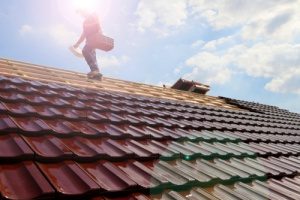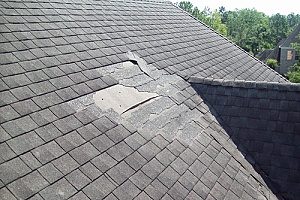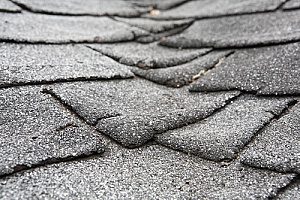 From winter to spring and summer to fall, your roof provides a solid defense against snow, rain, wind, hail, and heat. While your roof continues to be exposed to hazardous weather conditions, it remains vigilant to protect your home and its inhabitants. Unfortunately, roofs do not last forever. When your roof reaches or surpasses its expected lifespan, it may be time to consider a roof replacement. There will likely be some red flags in the months or even years prior that indicate the need for a new roof.
From winter to spring and summer to fall, your roof provides a solid defense against snow, rain, wind, hail, and heat. While your roof continues to be exposed to hazardous weather conditions, it remains vigilant to protect your home and its inhabitants. Unfortunately, roofs do not last forever. When your roof reaches or surpasses its expected lifespan, it may be time to consider a roof replacement. There will likely be some red flags in the months or even years prior that indicate the need for a new roof.
Average Life of a Roof
How long your roof lasts will primarily depend on the type of roof you own and how well you maintained it over the years. Common three-tab asphalt shingles are one of the most affordable roofing options. However, this affordability comes at a price – a reduced lifespan. Most roofs with asphalt shingles will last an estimated 15 to 20 years. You can expect architectural asphalt shingles to last a bit longer at an average of 25 to 30 years. Galvalume or metal roofing materials have an estimated lifespan of 30 to 45 years, and concrete tile generally lasts between 30 and 50 years.
Other factors can also impact the lifespan of your roof, such as the color, orientation, and slope of your roof. Darker-colored roofs typically absorb more heat than lighter-colored roofs. If the person lives in a warm climate with lots of sun, their roof may need to be replaced more often. If your roof has a slope that faces south, the sun will have a bigger impact which causes a reduction in the lifespan of the roof. Also consider the pitch of the roof. Roofs that have a high pitch will generally last longer as rain and snow are not able to settle as easily.
How Weather Affects Roofs
Where you live has a major impact on how long your roof lasts due to the differences in weather. If you reside in an area that experiences frequent temperature fluctuations or have harsh climate conditions, your roof will most likely have a shorter lifespan. Even if you live somewhere with near constant sunny skies and warm temperatures, your roof can still suffer. Heat and UV radiation can shorten the life expectancy of your roof. It is important to take weather into consideration when determining whether you need a roof replacement.
Roof Replacement Red Flags
 In addition to performing regular roof maintenance to keep your roof in optimal condition, keep an eye out for red flags that could indicate a problem.
In addition to performing regular roof maintenance to keep your roof in optimal condition, keep an eye out for red flags that could indicate a problem.
Damaged Shingles
Damaged shingles are one of the most noticeable red flags. You may find that your roof is missing shingles or that the existing shingles are significantly worn or damaged. This is often a result of strong winds, water damage, or old age. If you find that your shingles have developed cracks or are starting to curl, you may need to have your roof replaced.
Health Of Your Gutters
Your gutter system can also tell you a lot about the state of your roof. Gutters are designed to transport rain from your roof to an area away from your home’s foundation. It is normal to find certain debris inside your gutters, such as leaves or the occasional twig. However, if you start to notice granules in your gutters, there may be a problem with your roof. These granules are often bits of your shingles that break apart and end up in your gutters. If you notice an increasing amount of granules, roof replacement may be the next step.
Sagging Roof
To keep your home, family, and possessions safe from damage, your roof should be rigid and strong. Every component, from the decking to the shingles should be in place and there should be no components missing or severely damaged. Sagging is a major red flag that points to the need for roof replacement. Your roof may be visibly sagging from the inside or the outside and may affect numerous components of the roofing system. If sagging is not promptly remedied, any excess weight placed on the roof due to snow or debris could potentially cause a collapse.
Roof Leaks
Leaks are also a common red flag that can lead to a number of roofing problems. Leaks often occur when shingles or another layer of the roof fails, allowing water to seep through the cracks. Just because you do not see water leaking into your attic does not mean there is not a leak. Leaks can also develop inside walls or ceilings away from plain view. You my notice dark stains, wet spots, or even mold growth in your attic. Also be on the lookout for water pooling on your roof. Do not try to step on a roof that you believe is damaged or hazardous in any way.
Consequences of Neglected Roof Damage
 Failure to have these roof problems inspected and repaired could result in serious consequences. Short-term, your roof could experience a number of issues, such as leaks, mold growth, increased energy bills due to escaped air, and the introduction of pests and animals into your roofing system. Long-term, the effects of neglecting your roof can be even more substantial. Water damage can become severe, resulting in wood rot that weakens the integrity of your home. Your property value may decrease and the cost of repairs will no doubt increase. The longer you allow your roof to sit untouched, the more dangerous it will be for workers when it is time to make repairs.
Failure to have these roof problems inspected and repaired could result in serious consequences. Short-term, your roof could experience a number of issues, such as leaks, mold growth, increased energy bills due to escaped air, and the introduction of pests and animals into your roofing system. Long-term, the effects of neglecting your roof can be even more substantial. Water damage can become severe, resulting in wood rot that weakens the integrity of your home. Your property value may decrease and the cost of repairs will no doubt increase. The longer you allow your roof to sit untouched, the more dangerous it will be for workers when it is time to make repairs.
How Often To Replace Your Roof
How often should you replace your roof? There’s not a simple answer. When determining if you need a roof replacement it is important to consider all aspects of your roof, such as its age, condition, and how well you maintain it. It is also crucial to pay attention to red flags that could indicate the presence of damage. To learn more about professional roof replacement services or to schedule a free roof consultation, contact the expert roofing contractors at Beyond Exteriors today.